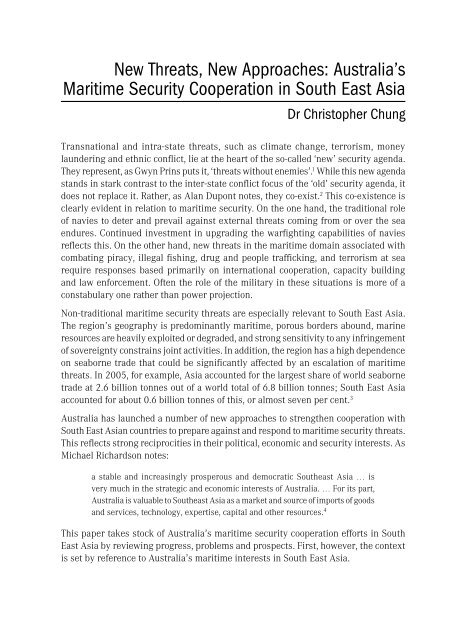Australian Maritime Issues 2007 - Royal Australian Navy
Australian Maritime Issues 2007 - Royal Australian Navy
Australian Maritime Issues 2007 - Royal Australian Navy
You also want an ePaper? Increase the reach of your titles
YUMPU automatically turns print PDFs into web optimized ePapers that Google loves.
New Threats, New Approaches: Australia’s<br />
<strong>Maritime</strong> Security Cooperation in South East Asia<br />
Dr Christopher Chung<br />
Transnational and intra-state threats, such as climate change, terrorism, money<br />
laundering and ethnic conflict, lie at the heart of the so-called ‘new’ security agenda.<br />
They represent, as Gwyn Prins puts it, ‘threats without enemies’. 1 While this new agenda<br />
stands in stark contrast to the inter-state conflict focus of the ‘old’ security agenda, it<br />
does not replace it. Rather, as Alan Dupont notes, they co-exist. 2 This co-existence is<br />
clearly evident in relation to maritime security. On the one hand, the traditional role<br />
of navies to deter and prevail against external threats coming from or over the sea<br />
endures. Continued investment in upgrading the warfighting capabilities of navies<br />
reflects this. On the other hand, new threats in the maritime domain associated with<br />
combating piracy, illegal fishing, drug and people trafficking, and terrorism at sea<br />
require responses based primarily on international cooperation, capacity building<br />
and law enforcement. Often the role of the military in these situations is more of a<br />
constabulary one rather than power projection.<br />
Non-traditional maritime security threats are especially relevant to South East Asia.<br />
The region’s geography is predominantly maritime, porous borders abound, marine<br />
resources are heavily exploited or degraded, and strong sensitivity to any infringement<br />
of sovereignty constrains joint activities. In addition, the region has a high dependence<br />
on seaborne trade that could be significantly affected by an escalation of maritime<br />
threats. In 2005, for example, Asia accounted for the largest share of world seaborne<br />
trade at 2.6 billion tonnes out of a world total of 6.8 billion tonnes; South East Asia<br />
accounted for about 0.6 billion tonnes of this, or almost seven per cent. 3<br />
Australia has launched a number of new approaches to strengthen cooperation with<br />
South East Asian countries to prepare against and respond to maritime security threats.<br />
This reflects strong reciprocities in their political, economic and security interests. As<br />
Michael Richardson notes:<br />
a stable and increasingly prosperous and democratic Southeast Asia … is<br />
very much in the strategic and economic interests of Australia. … For its part,<br />
Australia is valuable to Southeast Asia as a market and source of imports of goods<br />
and services, technology, expertise, capital and other resources. 4<br />
This paper takes stock of Australia’s maritime security cooperation efforts in South<br />
East Asia by reviewing progress, problems and prospects. First, however, the context<br />
is set by reference to Australia’s maritime interests in South East Asia.
















